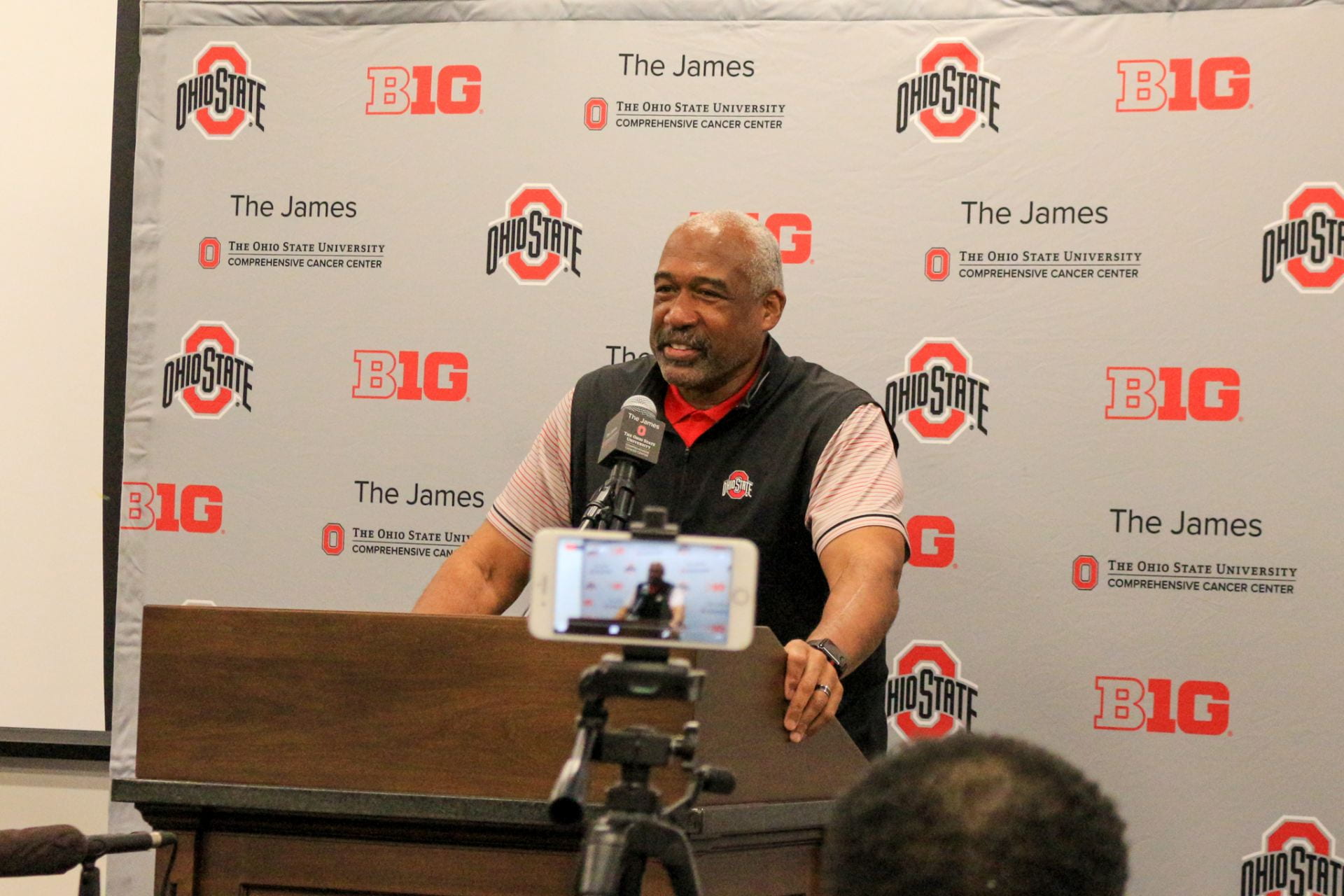Smith sounds off on current landscape of college sports

Athletic Director Gene Smith speaks to the media during an availability Wednesday. Credit: Jacob Benge | Assistant Sports Editor
A lot has changed in the world of college sports since before the pandemic.
With student-athletes now allowed to profit off of their name, image and likeness, an emerging transfer portal, potential College Football Playoff expansion and the alliance between the Big Ten, Atlantic Coastal Conference and Pac-12 all taking shape, Ohio State athletic director Gene Smith stressed that his department just needs to adjust with the times.
“Our landscape is changing significantly; the collegiate model that we all are used to is different today, and it will be significantly different in the future,” Smith said. “It’s just going to be a whole new ballgame as we move forward. So, lots of changes, and what we have to do is kind of get comfortable with the uncomfortable.”
At an Ohio State Board of Trustees meeting Feb. 10, the university announced 225 Buckeye student-athletes have made nearly $3 million in NIL endorsement deals combined.
Smith emphasized the value of NIL Wednesday, pointing to how it helps student-athletes on partial scholarships financially, both while in school and in the student loan process following their time at Ohio State.
“I’ve always been one to drive towards, ‘How do we provide more economic opportunities for young people?’ ” Smith said. “It is warming, it really is.”
Smith also advocated for federal legislation for NIL, saying he doesn’t think that the NCAA is “the answer in this particular case.”
An emerging aspect of NIL is the formation of collectives, which are donor-led entities that help student-athletes facilitate NIL deals. Collectives are independent from universities and typically run by boosters.
With collectives becoming a new wrinkle to NIL, Smith said the athletics department needs to exercise caution surrounding this factor.
“If we have to shift all of our focus to supporting collectives, then it’s just going to a whole new financial model,” Smith said. “I worry about it a little bit. I know there’s collectives emerging in our marketplace.”
In terms of helping student-athletes navigate NIL, Ohio State introduced the NIL Edge Team Jan. 22, which Smith described as an advisory group that serves as a middleman between brands and student-athletes in the NIL process.
Another key shift in the college athletics landscape has been the growth of the transfer portal. Ohio State football saw the impact of this growing aspect as 11 former Buckeyes transferred out of the program since the beginning of the 2021 season.
Although student-athletes are transferring at a higher rate than ever before, Smith said this doesn’t affect his department’s mission to provide student-athletes with opportunities to compete.
“We have to go to where the kids are today. Where I was, where you were when you came up, is a totally different place than where these kids are today,” Smith said. “It’s not about obligation, it’s about making sure that we pay attention to who we serve and putting them in places so that they can be successful.”
Since the College Football Playoff was implemented in the 2014 season, Ohio State has found itself in the tournament four times — including two appearances since Ryan Day took over as head coach in 2018.
While the CFP currently sits at a four-team model, momentum has grown behind expanding the playoffs to 12 teams — a change that Smith said he’s behind.
Although the College Football Playoff has become the endgame of the season for eight years, it has also changed how conferences have approached scheduling and conference play. The Big Ten is no exception to this trend, as there have been rumblings that the conference could ditch its current divisional makeup.
Smith said he’s “OK with losing divisions” but is interested in seeing other models of how the conference would operate. He added that there has been no conversation around shuffling the divisions, and the conference will either stay with the current divisions or dump them altogether.
The alliance between the Big Ten, ACC and Pac-12 was also formed with the early intentions of scheduling nonconference games between member schools of each conference. As recent trends have impacted Ohio State and the Big Ten as a whole, Smith said the alliance has strayed away from its initial scheduling aspirations.
“When we first started the alliance, everything was a little about scheduling, and that kind of shifted,” Smith said. “Conference contests, from a TV partner point of view, were just as valuable. So, we decided to walk away from that a little bit, but that doesn’t mean it might not come back up.”
Smith added that the general feeling around the Big Ten is to stick at nine conference games instead of dropping to eight — which would have made it easier to schedule nonconference games within the alliance.
Despite the ever-shifting college athletics landscape, Smith said he’s here to stay at Ohio State for the time being.
“I just go year to year,” Smith said. “I will know when it’s time for me to step away and when it’s time for Ohio State to have new leadership.”
Read More: Smith sounds off on current landscape of college sports

